Popular Cháo Lòng Variations

Cháo Lòng Miền Bắc

Cháo Lòng Bình Định

Cháo Lòng Miền Tây
Cháo Lòng: Ingredients and Preparation
Main Ingredients
Main Cooking Method
Preparation Process
Cháo Lòng: A Deep Dive
Cultural Significance
Taste
Texture
Aroma
Color
Serving Style
Serving Temperature
Accompaniment
- Youtiao or Dầu Cháo Quẩy
- Scallions and Ginger
- Bean Sprouts
- Fish Sauce
- Bún (Rice Vermicelli Noodles)
Occasions
Seasons
Special Diets
Calories
Popularity
Popular Similar Dishes
- Cháo
- Cháo Vịt
- Cháo Gà
Popular Dining Area
Cháo lòng is a Vietnamese rice porridge featuring sweet pork bone broth and various pork organs, such as the heart, liver, and intestines.
The rice, either sticky or regular, is often roasted before being cooked in the broth to a creamy consistency.
Pork organs are boiled, sliced, and added to the porridge, which is garnished with fresh herbs and served with seasonings like pepper and fish sauce.
This dish is a common comfort food in Vietnam and a part of traditional Vietnamese meals.
Cháo lòng symbolizes resilience in tough times and poverty. Born from necessity, it shows how people made hearty meals with few ingredients during food shortages, highlighting determination and family unity.
I’ll provide a comprehensive overview of this dish, covering everything from its ingredients and different versions to serving suggestions, the best places to try it, benefits and drawbacks, typical questions, and related dishes.
Key Points
Cháo Lòng Images
What Ingredients Are Primarily Used in Making Cháo Lòng?
Essential ingredients and distinctive traits of cháo lòng are highlighted below:
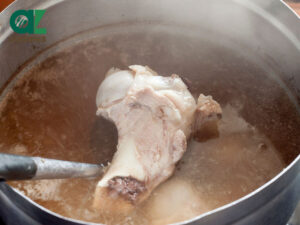
Broth
Pork bones are chopped and crushed to make a sweet broth. Cooks often utilize the deliciously sweet broth from boiling pork offal (called “nuoc xuyt”) for preparing the porridge.

Rice
Sticky rice or fragrant tender rice is roasted in a hot pan until golden before cooking. In some places, the rice is crushed to make the porridge smooth and fine, while many others leave the rice grains whole to allow them to expand in the porridge.

Pork offal
A general term for most pork internal organs cooked or grilled, such as heart, spleen, liver, sausage (usually made from large intestines stuffed with blood and various spices), tripe, stomach, small intestines, large intestines, tongue, eyes, etc.

Spices
Chili powder, ground pepper, ginger, green onions (and possibly bean sprouts) are added to the porridge bowl.
Understanding these key ingredients provides the foundation for exploring the diverse cháo lòng variations, each with its unique blend of flavors and textures.
What Are Common Variations of Cháo Lòng?
Below is an overview of 3 main cháo lòng variants, their distinct features, and suitable additions:
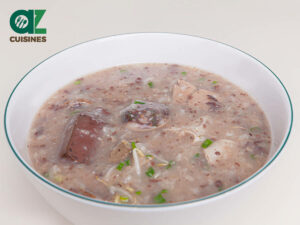
Cháo Lòng Miền Bắc
Thick and smooth porridge made from finely ground rice in bone and pork organ broth, with a rich, aromatic flavor. Popular as a morning dish.

Cháo Lòng Bình Định
Thin porridge with white and yellow hues from rice and turmeric, not darkened by blood.

Cháo Lòng Miền Tây
Yellowish-brown porridge with a toasted rice aroma features lemongrass pork fried sausage instead of blood sausage.
Exploring these variations of cháo lòng reveals a rich tapestry of regional flavors, each enhanced by its unique set of accompaniments and garnishes.
What to Serve with Cháo Lòng?
Here are some recommended accompaniments to enhance your cháo lòng experience:

Youtiao or Dầu Cháo Quẩy
Deep-fried dough sticks, often served as a crunchy side to complement the soft texture of the congee.

Scallions and Ginger
Used for garnishing, adding a fresh and slightly warm flavor to the dish.
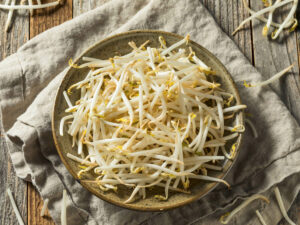
Bean Sprouts
Offered on the side for added crunch and freshness.
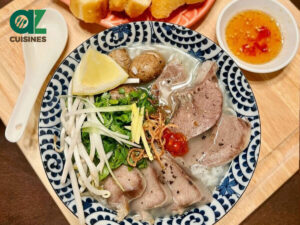
Fish Sauce
Used as condiments to enhance the savory aspects of the dish.

Bún (Rice Vermicelli Noodles):
These light and thin noodles can be a great accompaniment to cháo lòng, offering a different texture and a mild taste that balances the flavors of the congee.
Incorporating these accompaniments not only enriches the cháo lòng experience but also reflects the culinary diversity found in the various cháo lòng dining places across regions.
Where to Eat Cháo Lòng?
Discover the best eateries for cháo lòng in Hanoi, Binh Dinh, and Ho Chi Minh City right now:
In Hanoi
Quán Bà Lương
Address: 26 Phan Chu Trinh, Hoàn Kiếm District, Hanoi
Quán Bà Tý C
Address: No. 39 Châu Long, Ba Đình District, Hanoi
Cháo lòng Tô Hiệu
Address: Alley 235 Tô Hiệu, Cầu Giấy District, Hanoi
In Binh Dinh
Bánh hỏi cháo lòng Hồng Thanh
Address: 22 Phan Bội Châu, Quy Nhơn City, Bình Định Province
Cháo Lòng Thảo Loan
Address: 182 Trần Phú, Tuy Phước District, Bình Định Province
Bánh Hỏi Cháo Lòng Cô Năm
Address: 41 Nguyễn Chánh, Quy Nhơn City, Bình Định Province
In Saigon (Ho Chi Minh City)
Cháo Lòng 170B
Address: 170B Võ Thị Sáu, Ward 8, District 3, Ho Chi Minh City
Cháo lòng Miền Tây
Address: 172 Quang Trung, Ward 10, Gò Vấp District, Ho Chi Minh City
Cháo lòng Tân Hiệp
Address: 1 Mạc Thiên Tích, Ward 11, District 5, Ho Chi Minh City
Visiting these renowned eateries offers a unique opportunity to weigh the cháo lòng pros and cons, experiencing firsthand the variations and specialties of each region.
Pros and Cons of Eating Cháo Lòng
Let’s consider the strengths and weaknesses of cháo lòng:
Pros
Cons
Plus, make sure to review the often-asked questions.






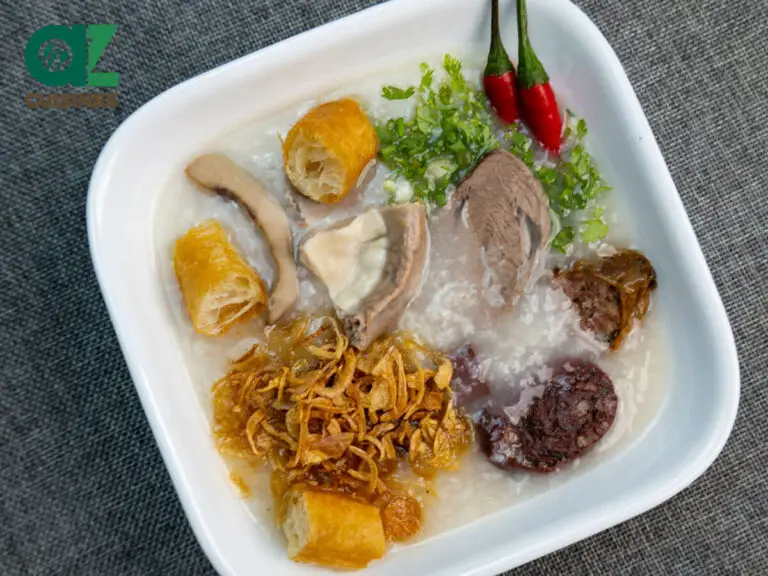





Truc Tran (Kris)
Senior Food Editor
Expertise
Home Cooking, Meal Planning, Recipe Development, Baking and Pastry, Food Editor, Cooking-video Maker, Vietnamese Food Evaluation Expert
Education
Truc Tran (Kris), an experienced food writer and editor, is great at exploring and describing global cuisines, from simple street food to fancy dining. In her writing, she skillfully mixes different flavors, cooking methods, and culinary traditions, showing the unique character of various cultures through their food and drinks. On azcuisines.com, Kris highlights her knowledge, especially in Asian cuisine and worldwide traditional dishes.